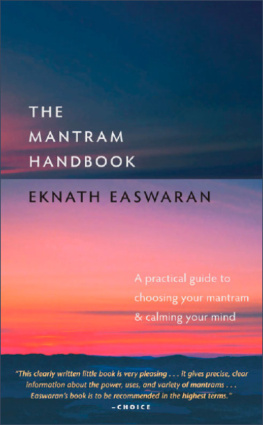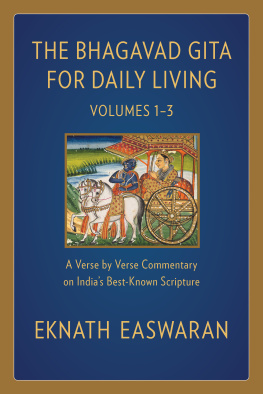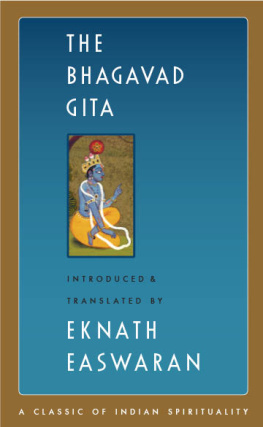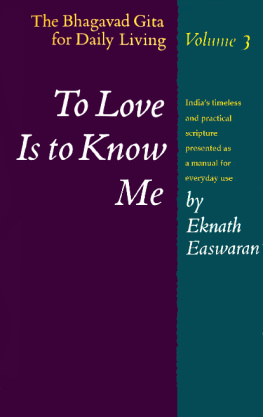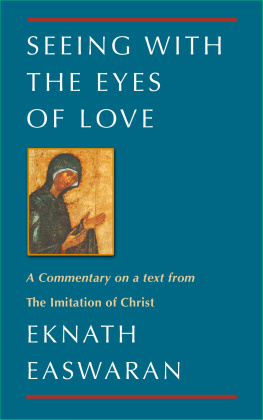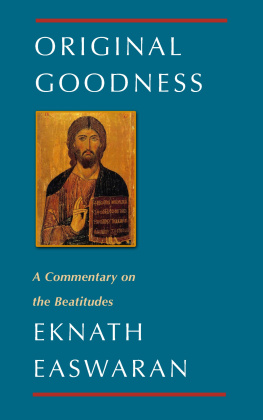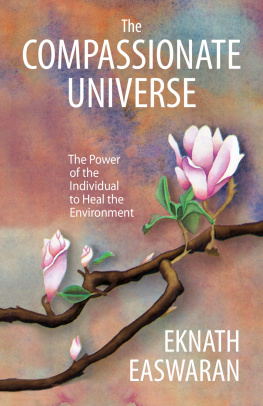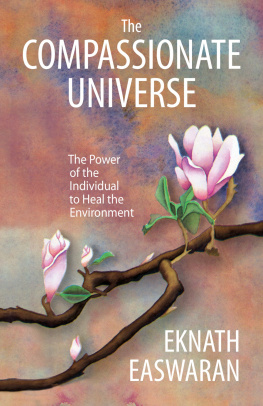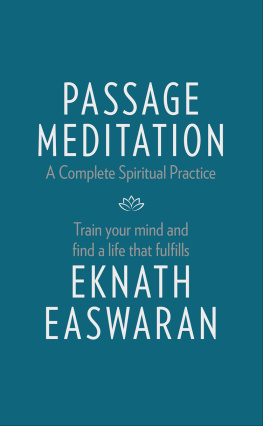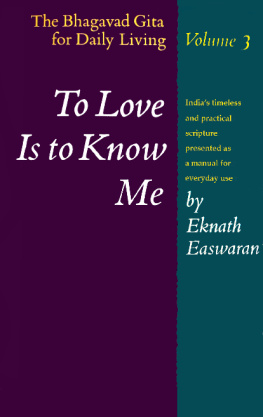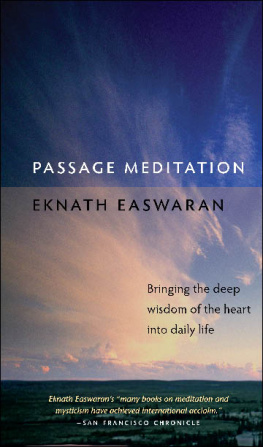

The Mantram Handbook
A Practical Guide to Choosing Your Mantram & Calming Your Mind
EKNATH EASWARAN
Foreword by Daniel H. Lowenstein, MD

NILGIRI PRESS
Table of Contents
Foreword: The Brain, the Mind, & the Mantram
By Daniel H. Lowenstein, MD
As a physician and neuroscientist, I tend to gaze at human behavior through the lenses of biology. Four billion years of evolutionary trial and error have led to the creation of this magnificent entity we call the brain, the physical source of our behavior and the seat of our individual consciousness. The collective good that has been wrought by this extraordinary network of cells and connections the most complex physical entity in the known universe is staggering. When singularly focused on an idea or task, our brain and mind have a limitless capacity to explore, solve, and create.
And yet, as I watch the ways of people, as I listen to my patients stories, as I share observations with friends and colleagues, grocery clerks and taxi drivers, as I contemplate my own fifty-plus years of conscious awareness, I am struck by the ongoing parade of conflicts and challenges and mental strife. How many of us can recall a week, let alone a day, where we were not wrestling with something that was the source of psychic discomfort? We fear failure. We are swept with irritation and impatience, with anxiety over events that have yet to occur, and with disappointment over events that have already occurred. We carry guilt, worry, and discontent about our health, our accomplishments, our bodies, our memory, our parenting skills. Interspersed in this negative stream are random thoughts that erupt and sweep our consciousness: a sudden craving for pizza, a vision of ourselves in a new, attractive sweater, a longing to visit Hawaii, a replay of a conversation from yesterday. The list seems endless!
Why does this happen? Why does our consciousness flow like a relentless deluge of bothersome or nonproductive thoughts, when our brain and mind have the capacity to bring a laser focus to a single task?
Modern neuroscience has begun to reveal the biological underpinning of parts of our consciousness. We now understand, for example, that the emotional experience of fear requires the activation of the amygdala, a small, globular collection of neurons (nerve cells) located deep inside the temporal lobe. The perception of conflict, whether internal or external, involves a stretch of brain along the midline known as the anterior cingulate. The orbitofrontal cortex, located at the very front part of the brain, has a critical role in weighing reward and punishment, which is the basis of decision-making.
Yet, despite these advances, we still have no understanding about the nature of the recurrent and unsatisfying thoughts that distract our mind. Zen teachings refer to this as the monkey mind, as if there were a troop of mischievous monkeys jumping and bouncing between every corner of our consciousness.
And this is just at the surface of our brain activity; these are the thoughts of which we are aware. We all recognize that there is a realm of mind at the subconscious and unconscious levels, but few appreciate just how vast this realm must be. As one simple but graphic example, consider how we use vision to perceive the world. What constitutes the experience of seeing? In fact, we are not limited to items that enter our conscious awareness. We know this in part because of the discovery of a remarkable phenomenon called blindsight. There are rare individuals who, as a result of injury to specific regions of their visual cortex at the back of the brain, have lost their capacity to see. This is a special kind of blindness that is present in a small percentage of blind people. The blindsighted see nothing, just as you see nothing from the back of your own head. Now lets try the following experiment. We tell the blindsighted person that we are going to test his vision by holding our hands up in front of him and briefly moving the fingers of our right or left hand. We then ask this person which hand is moving. Our test subject protests, Dont waste your time. I cannot see anything! To which we respond: We understand but just do your best. It may feel like you are guessing, but you need to choose right or left. The experiment begins, and, amazingly, the subject is able to choose the correct side each time.
Is this surprising? Perhaps it is not. Why should we assume that vision is only limited to those perceptions that enter our conscious awareness? In fact, our visual system is processing a huge amount of sensory information that strikes the eyes but never bubbles up to the surface of our conscious experience of seeing the world. Now take this one step further. If there is a realm of brain activity below the surface that is dedicated to something as relatively simple as analyzing the light patterns that strike our eyes, what about all the other activities of the brain and the mind?
Which brings me to the mantram.
By chance almost twenty years ago I met Eknath Easwaran. He was interested in the world of medicine and the workings of the mind. In exchange for my medical consultation he gave me a copy of his book Meditation, which I carefully placed on my nightstand and forgot. Fortunately, my wife picked it up and gradually helped me and our children to appreciate the wisdom of this remarkable man. Over the years, I had numerous conversations with Easwaran, attended retreats at the Blue Mountain Center of Meditation, and began to recognize the brilliance of his ability to distill and convey the essence of the worlds great spiritual traditions. His eightfold body of spiritual disciplines, described in later in this book, is an elegant, logical, and practical approach for finding fulfillment and peace in everyday living.
As Easwaran emphasizes, it is important to consider all eight of these disciplines together, rather than as separate practices from which to pick and choose. However, of the eight practices, I have found the mantram to be powerfully transformative yet simplest to use. In this book, Eknath Easwaran explains how to use the mantram by silently repeating a few words from one of the great spiritual traditions, words like Om mani padme hum or Ave Maria.
The mantram works specifically as an antidote to the daily conflicts and intrusions filling our unquiet minds. At the most superficial level, repetition of the mantram causes the brain to swing from barely connected thoughts to a simple phrase that holds the attention and thus slows down the mind. The science of neurobiology gives another way to understand how the mantram could be working. From studies using magnetic resonance imaging (MRI), we know that concentrating on a short phrase will activate specific areas in the front and side of the brain. These areas, the frontal and parietal lobes, are involved in selective attention the capacity to maintain a single focus despite the presence of distracting stimuli. In this way, the mental repetition of a simple phrase like a mantram can provide a guidewire to move your attention away from a troubling stream of thoughts. It is as though the mantram provides access to a peaceful, grounded center that puts our cravings, drives, and other immediate needs in perspective.
Does the mantram also work on deeper levels of consciousness? In my own experience, I have seen that it does. After I had repeated the mantram consciously over a period of time, I found the words arising naturally when I faced a situation of fear or distress. In fact, now I sometimes become aware of the mantram repeating itself before I actually realize that I am in a predicament. This type of brain learning, where an act frequently repeated becomes an unconscious activity, is related to the recruitment of more and more neurons in brain regions that are activated by unconscious as well as conscious activity. Thus a skilled soccer player sees an opening and kicks a perfect goal without thinking consciously about the force required or the correct angle. Thus you and I having learned to ride a bicycle use our body to steer, move forward, and brake properly without conscious thought.
Next page
